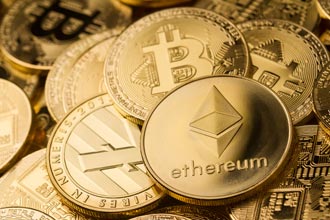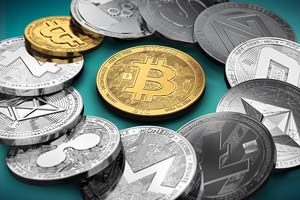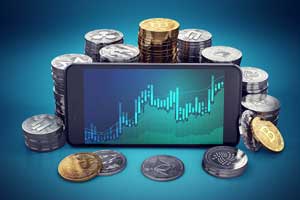The Best Cryptocurrencies To Watch In 2021
With crypto prices soaring and more attention than ever on the sector, investors need to know which are the best cryptocurrencies to watch in 2021.
This new asset class is coming of age in real time, right before our eyes.

And while Bitcoin dominates the space and gets most of the headlines in the mainstream financial media, it is far from alone.
According to CoinMarketCap, about 9,000 cryptocurrencies exist – a number that grows every day.
Obviously, not all of those projects will survive. I'd say it's likely 99% of them will fade away – most of them sooner rather than later.
In fact, more than 1,600 cryptocurrencies are already "dead coins" according to the website 99Bitcoins.
That means investors can't go out and buy any random cryptocurrency and expect Bitcoin-like gains.
Instead, investors need to educate themselves (Smartbillions.com's "Ultimate Guide To Cryptocurrency is a good resource) and focus on the projects with the most promise.
Unfortunately, there's a lot of noise out there, and it's hard to know who to trust.
That's why we've compiled this list of cryptocurrencies to watch. It's an honest assessment of the quality of most of the top projects. It includes cryptos that get a lot of attention as well as lesser-known projects that should be getting more attention.
The opinions are based on ratings from multiple websites that constantly evaluate the state of these projects as well as the insights I've gained from writing and researching cryptocurrencies for the past 10 years.
The ratings here are based on several attributes that set quality projects apart:
- User activity/adoption: Does the project have a lot of users? Are those numbers growing?
- Developer team quality/activity: What are the credentials of the developer team? How often is the project upgraded? What does the roadmap look like?
- Quality/usefulness of the technology: Why was the crypto/token created? What's the use case? How advanced is the technology? How does it compare to similar projects?
- Long-term value: Has the price gone up as much as other cryptos during bull markets? Does it have the backing of any prominent investors?
- Potential risks: Is the network vulnerable to attack? Is it subject to congestion that slows transaction times and increases fees? Are other, newer projects better?
Below, we've listed what our research shows are the top cryptocurrencies to watch in 2021. For a bit more perspective, I've also included the FCAS (fundamental crypto asset score) ratings from the FlipsideCrypto website. FCAS grades on a 1,000-point scale, with the 900-1,000 range being the best. The FCAS score is based on three factors: user activity, developer behavior, and market maturity, which measures risk and liquidity.
The 12 Best Cryptocurrencies to Watch
No. 1: Bitcoin (BTC)
FCAS score: 907
Why it was created: Bitcoin is the crypto that started it all back in 2009. The 2008 financial crisis inspired a mysterious figure known as Satoshi Nakamoto to build a decentralized cryptocurrency outside of the control of central banks and governments.
Why it matters: Bitcoin has emerged as a "store of value" akin to gold. That's why so many investors are buying it – retail investors as well as prominent billionaires. The main reasons for this are scarcity and security. Regarding scarcity, only 21 million bitcoins will ever exist, and nearly 19 million have already been mined. As for security, the network itself has never been hacked or compromised. That's a testament to the code that runs the network as well as the enormous amount of computing power the miners use to verify the Bitcoin blockchain. While Bitcoin can't do a lot of the fancy tricks other cryptos can do, its role as digital gold ensures it will remain the leader. Look for the Bitcoin price to reach $100,000 by Labor Day.
No. 2: Ethereum (ETH)
FCAS score: 971
Why it was created: Ethereum, the No. 2 crypto, was the brainchild of Vitalik Buterin. Fascinated by Bitcoin, he sought to create a blockchain platform capable of executing "smart contracts." Such a contract executes when the software determines that the conditions set forth in the code (and agreed upon by the participants) have been met.
Why it matters: The "smart contract" concept is responsible for much of the innovation in crypto today. Most of DeFi is built on the foundation of the Ethereum network. Hundreds of cryptocurrency tokens built on standards like ERC-20 run on Ethereum. In short, Ethereum is a vital piece of the "crypto economy." In some ways, it has become a victim of its own success, resulting in network congestion and soaring transaction fees. That's why a major upgrade, Ethereum 2.0, is in the works and expected to deploy over the next year or so. This upgrade will make the network more scalable and secure. But it's a major change. Any serious hiccups in this transition could affect the whole crypto ecosystem. ETH is up about 147% in 2021.

20X Bigger Than Bitcoin
For every $1,000 you could make with Bitcoin, this special trade could make you as much as $20,040 instead.
No. 3: Cardano (ADA)
FCAS score: 963
Why it was created: The Cardano project started in 2015 by founder Charles Hoskinson, who had also helped found Ethereum. It had its ICO in 2017. Hoskinson set out to create a "third generation" cryptocurrency that would solve common crypto issues like scalability, security, and interoperability. Unlike most cryptocurrencies, which borrow heavily from existing projects, Cardano's code was built from scratch.
Why it matters: Think of Cardano as the tortoise of crypto, with all the others as hares. Hoskinson put together a team of top-notch developers and assigned them to work on Cardano's modules. The code is also published and peer-reviewed along the way – a degree of diligence unheard of elsewhere in crypto. This project was long overlooked because of its painstaking development process. But Cardano is among the top projects for developer activity now. Upgrades to the protocol are coming one right after the other. This is a network that can handle smart contracts, DeFi, NFTs, and just about anything else in the crypto universe. And traders have started to notice – the price has soared 565% since Jan. 1.
No. 4: Polkadot (DOT)
FCAS score: 905
Why it was created: The Switzerland-based Web3 Foundation created Polkadot in 2016, with the ICO taking place in 2017. Among the founders is Gavin Wood, a co-founder of Ethereum. Wood sought to create a crypto designed from the ground up to use the "proof of stake" network verification system, as opposed to the "proof of work" system that Bitcoin and (for now) Ethereum use. Polkadot also seeks to bridge public and private blockchains, permission-less networks, and oracles (the sources of data that settle smart contracts).
Why it matters: As a multichain network, Polkadot can process multiple transactions in parallel, making it easy to scale. The key idea here is that Polkadot can transfer any kind of data across not just its own blockchain, but others as well. The versatility of this network lends itself to a wide range of use cases, from smart contracts, to file storage chains, to Internet of things chains that will help enable device-to-device communications. There are already nearly 400 projects being built on the Polkadot network. And traders have noticed the immense potential – the price of DOT is up about 274% so far in 2021.
No. 5: XRP (XRP)
FCAS score: 831
Why it was created: A company called Ripple released XRP in 2012. The goal was to create a fast, secure global payments system that could compete with legacy systems such as SWIFT. It was conceived by Jed McCaleb (who later went on to create Stellar).
Why it matters: XRP is one of the oldest cryptocurrencies, and it has a large and loyal following. But it has a complicated history that has come back to bite it in 2021 – namely, the link between Ripple the company and XRP the token. It's why the token is now known only as "XRP," not "Ripple." In December, the SEC, wary of cryptocurrencies that may be securities, filed a case against Ripple executives Chris Larsen and Brad Garlinghouse. The case alleges the 14.6 billion units of XRP they sold to the public were unregistered securities. This is a cloud over XRP that has restrained its price. However, once the SEC case has been decided, the XRP price will likely jump up. Ripple says hundreds of financial institutions are using its RippleNet service, which is the primary use for XRP tokens (which doesn't violate any securities laws). Be cautious with this crypto.
No. 6: Uniswap (UNI)
FCAS score: 911
Why it was created: Great story. A rival decentralized crypto exchange, SushiSwap, created its own token (SUSHI) to reward its users and serve as a governance mechanism (holders of the token can vote on changes to the protocol). That move swayed a lot of Uniswap customers to switch to SushiSwap. So Uniswap also created its own reward/governance token, the UNI, to lure them back. The UNI is an ERC-20 token that piggybacks on the Ethereum network.
Why it matters: The UNI token is now an integral part of the Uniswap exchange, where crypto users can "swap" tokens without trading them on a centralized exchange like Kraken or Binance. As one of the largest decentralized exchanges, Uniswap is a key player in the rapidly growing world of decentralized finance. And it's building a moat. Just this week, Uniswap released a new version to increase its capital efficiency and prevent others from copying its code as SushiSwap did. While the UNI doesn't have the utility of Cardano or Polkadot, it does serve an important niche role. And traders have been snapping it up, making it the No. 1 DeFi token by market cap. UNI is up 477% since Jan. 1.
No. 7: Chainlink (LINK)
FCAS score: 932
Why it was created: A company called SmartContract.com created Chainlink in 2017 via an ICO. The purpose was to create a decentralized oracle network, with "oracles" being the source of data required to settle smart contracts running on networks like Ethereum. LINK is an ERC-677 token, a more advanced standard that's backwards-compatible with the earlier, more common ERC-20 standard.
Why it matters: Chainlink's oracle serves as a "middleman" between smart contracts and the data sources. It provides the secure, reliable link to data required to make smart contracts trustworthy. Chainlink is also a core piece of the DeFi ecosystem, which depends heavily on smart contracts. Many top DeFi projects use it, including Aave, Synthetix, and yearn.finance. Throughout crypto, more than 400 projects use Chainlink's oracle network. Several Big Tech names also have partnered with Chainlink, including Alphabet Inc. (Nasdaq: GOOGL), Oracle Corp. (Nasdaq: ORCL), and Intel Corp. (Nasdaq: INTC). Chainlink is also working with SWIFT. The World Economic Forum named it one of the 100 most promising technology pioneers of 2020. In February, Chainlink launched a major upgrade that added access to 10 times more data. The LINK price is up 148% since Jan. 1 and more than 500% since I first wrote about it last June.

The Best Crypto Moves to Make
These special plays have the potential to hand you the BIGGEST gains of your life – starting TODAY.
No. 8: Stellar Lumens (XLM)
FCAS score: 909
Why it was created: Jed McCaleb left the Ripple project to create Stellar in 2014. He wanted to create a crypto to make cross-currency transfers easy and cheap. The name of the token is Lumens.
Why it matters: If you want to send US$100 to a person in Japan and have them receive it in yen in a matter of seconds for a negligible fee, Stellar is the system you want. This avoids wire transfers that require high fees and take three to five days. Sending remittances is the primary use case. Stellar has partnered with International Business Machines Inc. (NYSE: IBM) to create the IBM World Wire, which offers the quick currency transfer service to financial institutions worldwide. So Stellar could benefit if XRP takes any damage from the SEC case. Stellar isn't often in the crypto spotlight, but it's a solid project with a strong focus. The Stellar Lumens token is up 175% so far this year.
No. 9: Dogecoin (DOGE)
FCAS score: 860
Why it was created: Jackson Palmer, a product manager with Adobe Inc. (Nasdaq: ADBE) and Billy Markus, a software developer at IBM, created Dogecoin in 2013 to satirize the early hype around cryptocurrencies. It's a fork of Litecoin. They adopted a meme of a Japanese Shibu Inu dog as the official Doge logo.
Why it matters: Frankly, Dogecoin shouldn't really be on this list. Dogecoin was all but forgotten by 2018. But people rediscovered it in 2019 when Elon Musk started tweeting about it. In January, a group of Redditor investors sought to push the price of DOGE from less than a penny to $1. They failed, but did manage to produce a peak gain of 1,400% from Jan. 1 to Feb. 8. All that despite the fact Dogecoin had no use case. But that changed suddenly on March 4, when billionaire Mark Cuban, owner of the Dallas Mavericks, said the NBA team would accept Dogecoin as payment for tickets and merchandise. While it's mainly a publicity stunt, who knows where this might lead. This old dog keeps coming up with new tricks.
No. 10: Aave (AAVE)
FCAS score: 905
Why it was created: Aave has its roots in the ETHLend cryptocurrency launched in 2017. Founder Stani Kulechov noted a lack of borrowing and lending applications on the Ethereum network and set out to fill the void. That makes it a DeFi pioneer. AAVE is an ERC-20 token.
Why it matters: At this point, there is no shortage of borrowing and lending on Ethereum, as last year's explosion in DeFi proved. But Aave has a few distinct features, such as flash loans, a pointed effort to maintain decentralization, and complete network transparency. These features give borrowers and lenders a clear picture of Aave's financial health at all times. Aave also allows borrowers to choose between fixed and variable interest rates. Aave has nearly $5 billion worth of locked assets, about a third of the market. And there's an active and growing developer team, with code commits growing 763% last year according to a report by Outlier Ventures. The AAVE token is up about 310% year to date.
No. 11: Solana (SOL)
FCAS score: (Not rated)
Why it was created: Two former Qualcomm Inc. (Nasdaq: QCOM) engineers, Anatoly Yakovenko and Greg Fitzgerald, founded Solana Labs in 2017 and released the SOL token to the public just last year. The goal was to create a high-performance cryptocurrency that was decentralized, secure, lightning fast, and massively scalable.
Why it matters: Solana is still so new the crypto ratings websites haven't listed it yet. But I think this project could really catch the crypto world by surprise. It uses an innovative hybrid consensus mechanism that incorporates time stamps to maximize efficiency. Block times are just 400 milliseconds, which means Solana can process between 50,000 and 60,000 transactions per second. That far outstrips both Bitcoin (7 TPS) and Ethereum (15 TPS). That's on par with Visa Inc. (NYSE: V), which claims it can handle 65,000 TPS. Fees are almost invisible, just 0.00005 SOL (currently $0.000725). Meanwhile, Solana can do everything other advanced cryptos can do – including smart contracts and DeFi. It's already making progress on the DeFi front. The first automated market maker (decentralized exchange) built on Solana, Raydium, launched in February. The project also partnered with Chainlink to build a super-fast oracle. Stablecoin Tether is also on board, recently releasing its USDT token on the Solana blockchain. This project could easily sneak in and take DeFi market share while the Ethereum 2.0 transition drags on (and high fees drive crypto users to seek other options) while other DeFi contenders fail to match what Solana can offer. SOL is up more than 1,000% since Jan. 1.
No. 12: Synthetix (SNX)
FCAS score: (914)
Why it was created: The Synthetix network was launched as Havven in 2017 to mint a single stablecoin, nUSD. But founder Kain Warwick soon realized the network could just as easily be used to create synthetic assets. So he changed the name to Synthetix to reflect this ability. SNX is an ERC-20 token.
Why it matters: Synthetix is the crypto version of derivatives. Using the SNX token and the magic of smart contracts, anyone can create "synthetic" assets. You stake SNX and create a synth token of the underlying asset. So a synth token of AAPL stock would be designated as an sAAPL token. It's a way to get exposure to an asset without actually owning that asset. The network uses crypto oracles like Chainlink to get the real world trading data on the underlying asset. And Synthetix is not exclusive to cryptocurrencies. You can use it to gain synthetic exposure to stocks, real estate, bonds, precious metals – even fiat currencies. According to DeFi Pulse, nearly $3 billion of assets were locked in the Synthetix system in February, though that has declined to less than $2 billion since. This innovative project has stunning potential. SNX is up about 130% year to date.
Put These Tiny Cryptos on Your Radar NOW
A surge of interest from institutional investors is setting the stage for a rally in a slew of small digital coins.
But understand this: These under-the-radar players are much more affordable than Bitcoin.
Some are so hot, even a small stake could transform into a humble fortune in 2021.
One is trading for just $5 – and could deliver a 328% profit in just a few years.
Disclaimer: Any performance results described herein are not based on actual trading of securities but are instead based on a hypothetical trading account which entered and exited the suggested ...
more


